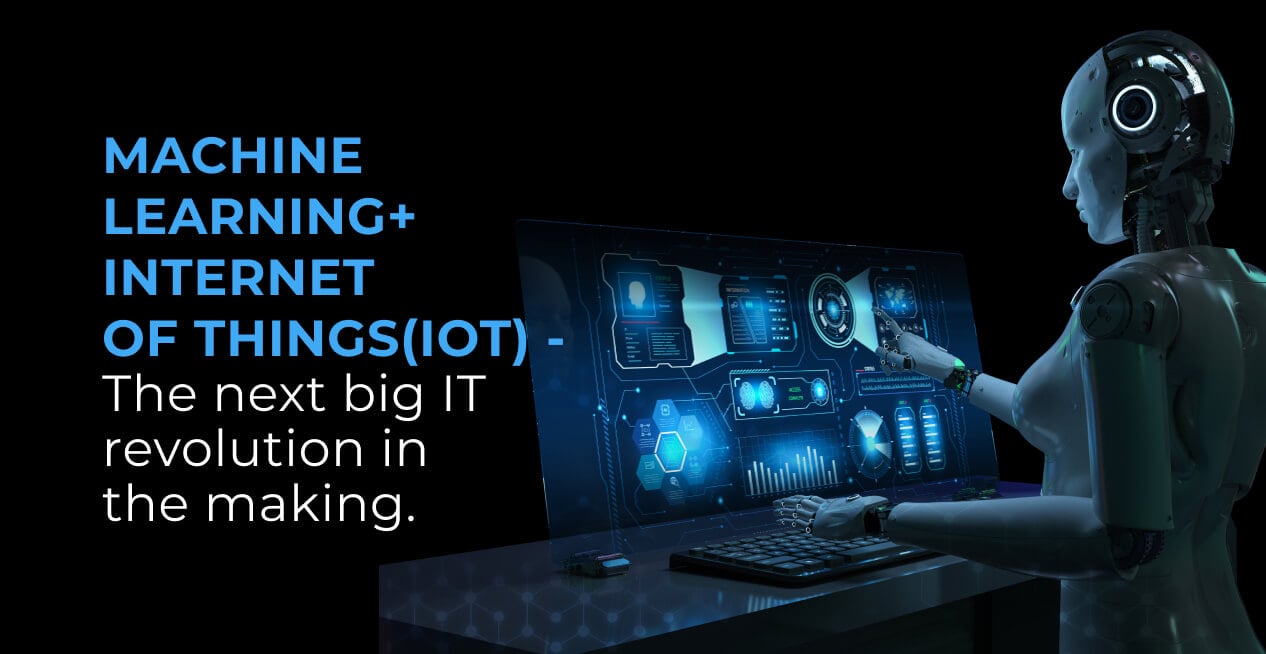The 21st century has seen the advent of some ingenious inventions and technology. From human genome mapping to Big Data Analytics, Artificial Intelligence (AI), Machine Learning, Blockchain, Mobile digital Platforms (Digital Streets, towns and villages),Social Networks and Business, Virtual reality and so much more. Combinations of these technologies have slowly changed the way we live. We are using them for something as basic as everyday chores to something as big as running a company! One such combination of technologies is Machine Learning in IoT (or Internet of Things) which has surely changed the way we perceive and interact with our surroundings.
What is IoT or Internet of Things?
As the name suggests, IoT is a technology that connects inanimate objects virtually to perform a variety of tasks at hand. A network of physical objects—“things” is built with the help of sensors and software as well as other technologies which help these inanimate things to connect and exchange data with other devices and the internet. These objects thus become ‘intelligent’ to a small extent.
The idea of adding sensors and intelligence to physical objects first came up in the early 1980’s. Some university students pondered over the idea of enabling a coca cola vending machine to report its contents to a remote location. They were successful but the technology they used was bulky and functions of the machine were limited.
Thereafter, in 1999, Kevin Ashton, a computer scientist at Procter and Gamble suggested a unique radio- frequency identification(RFID) chip on products which would help track these products on the supply chain. He coined the term, “ Internet of Things” for this technology and the name stuck. The term referred to all intelligible objects who were capable of communicating with each other and exchanging some form of data via the internet.
What is Machine Learning?
Machine Learning is a branch of Artificial Intelligence Technology which enables machines to imitate the learning mechanism of humans. It helps a machine to use data and algorithms and understand behavioral and technical patterns while gradually improving machine accuracy.
Arthur Samuel, an American pioneer of artificial intelligence research, coined the term at IBM after his famous IBM checkers game which was a televised event. Millions of people saw for the first time how a computer beat Robert Nealey, a popular checkers player in a digital game of checkers. This small achievement was a major milestone in the field of Machine learning and Artificial Intelligence.
Ever since, Machine learning has become an integral part of data science and AI. With the help of statistical methods and algorithms, machines are trained to predict, and to uncover key insights. These insights subsequently enhance decision making within applications and businesses, ideally impacting key growth metrics. Machine learning applications are finding their way into all major industries.
Incorporating Machine Learning into IoT
In 2000, LG introduced the first ever smart refrigerator capable of making video calls and accessing the internet. This was the first ever commercialisation of IoT and by 2008, the number of IoT devices exceeded the human population on earth. IoT adoption has ever since become inevitable. But for IoT to evolve, it was observed that it needs to be more humane. Machine Learning delivers on this need.
Machine Learning in IoT is revolutionary in the way that it gives the ability to predict behavior, to quite some extent. It helps extract precise information from huge amounts of raw data collected from IoT devices via sophisticated algorithms. The role of Machine Learning in IoT is to make IoT application development devices able to understand the unstructured, multimedia data while intelligently reacting to both users and changes in its environment. This supplements efficient and more humane systems capable of making intelligent decisions.
How can we benefit from Machine Learning in IoT?
There are many ways of applying learning algorithms to IoT devices. This process not only makes them intelligible but is more ergonomic and sustainable by reducing human resource and turnaround time to perform a task. Given below are some of the ways we can benefit from Machine Learning Inference in IoT.
- In utilities, energy can be saved by predicting the usage individually and then allocating dynamically. Since this generates a lot of data, Machine learning could be introduced to smart meters which would further map data and patterns of energy consumption and allocate accordingly thus saving manpower, energy and money.
- Manufacturing incurs heavy losses due to faulty operations and products. With the help of Machine Learning inferred IoT devices, any fault or anomaly in operation can be detected early on and dealt with accordingly thus reducing wastage of both, human resource and money.
- Smart and targeted marketing: Many marketing companies are also incorporating Machine Learning with their IoT platform to help improve performance of B2B sales teams. This is done by recording, transcribing and analyzing the content of all sales-oriented calls, web conferences and emails. JPMorgan, the financial giant also uses an AI copywriter which writes more customer friendly content for its customers.
Apart from these, almost all industries can benefit from the combination of technologies of ML and IoT. Resulting automation from this combination has proven to be much more efficient and time saving.
What are the applications of machine learning?
Use cases of Machine Learning and IoT coupling helps give us a brief glimpse of the potential of the combination of these technologies.
Ecommerce
Several Ecommerce websites have amped up their marketing by introducing a chatbot interface that can address any customer query, take feedback, and enhance customer service manifold. Data collected by Chatbots can also be used to predict consumer behavior and preferences. Some of the most popular companies successfully use AI chatbots including Sephora, H&M, Staples, etc.
Self Driving Car-Tesla
Tesla cars are prime examples of wonders of ML and IoT coupling. Here the car is the “thing”, which, with the help of AI and ML, has been extremely successful in analyzing and predicting the behavior of people and cars in multiple circumstances. All Tesla cars run on a network and are mutually adaptive. This means that via a resilient network when one car adapts to something new , other cars “learn” from it. This adds to the security of the driver and betters the driving experience like no other.
Computer Vision
Computer vision refers to the branch of AI and ML which enables computers and machines to read information from images, videos, graphic data and take actions or make recommendations based on the information derived.
Amazon Rekognition is one such Computer Vision tool which detects objects, scenes, faces in visual inputs. Integrated with AWS, Rekognition has become a fast, scalable, reliable and secure image recognition platform to help its users get quick insight and new revenue opportunities.
Smart Health Tracking Accessories
According to research conducted by Statista, the number of globally connected wearable devices is about to reach 1 billion. Examples of wearable smart devices included smart watches, armbands, chest straps, shoes, helmets, glasses, lenses, hearing aids and even textile amongst many others.
Irregular heart rhythm detection Sensors in Apple watch and heart murmur detection software in Eko’s electronic stethoscope are best examples of successful smart IoMT’s (Internet of Medical things). Here, Machine Learning helps retrieve a huge amount of data from these smart devices and help identify underlying patterns which are extremely useful for healthcare. The wearable IoT devices learn to identify these patterns which might be indicative of poor health in the long run and help with early diagnosis.
These are, but a few out of many successful machine learning application examples in different industries which have taken the world by storm. Each one of them is extremely innovative and the next big step in day to day automation.
Current Scenario and Challenges faced in ML-IoT coupling
Global Market size of ML in IoT stood at USD 78 bn $ in 2022 and is expected to double by 2032 with an average CAGR of 6.2%. The growing number of smart devices and keen interest in collection of Big Data is further boosting growth of intelligent IoT solutions. There are also many software for Machine Learning in the market which are driving these numbers. However, there are certain challenges that the AI and IoT industry is experiencing of late. Given below are three such major challenges.
Storage
IoT devices are restricted to small storage spaces which inhibits Machine Learning and use of its extensive algorithms.
Vulnerability
Smart IoT devices are more vulnerable to cyber attacks since they regularly upload data and communicate via the internet. Devices can be breached and its algorithms can be changed to “learn” irrelevant or harmful tasks.
Lack of skilled labor
Worldwide, there is an acute shortage of data visualizers, AI/machine learning architects, and knowledgeable developers who could cater to growing demand for smart IoT products .
Future Prospects
As Robert Canon has rightfully said, “Everything that can be automated will be automated.” One can easily imagine an autonomous IoT ecosystem with embedded intelligence capable of making decisions and understanding copious amounts of information. Collaboration of Machine learning and IoT are surely the stepping stones to such an ecosystem. Mutually beneficial, Machine learning enhances IoT with decision making whereas IoT facilitates data exchange for ML. This symbiotic relationship can be foreseen to be the next technological revolution in the making and top most benefit of machine learning and IoT.









